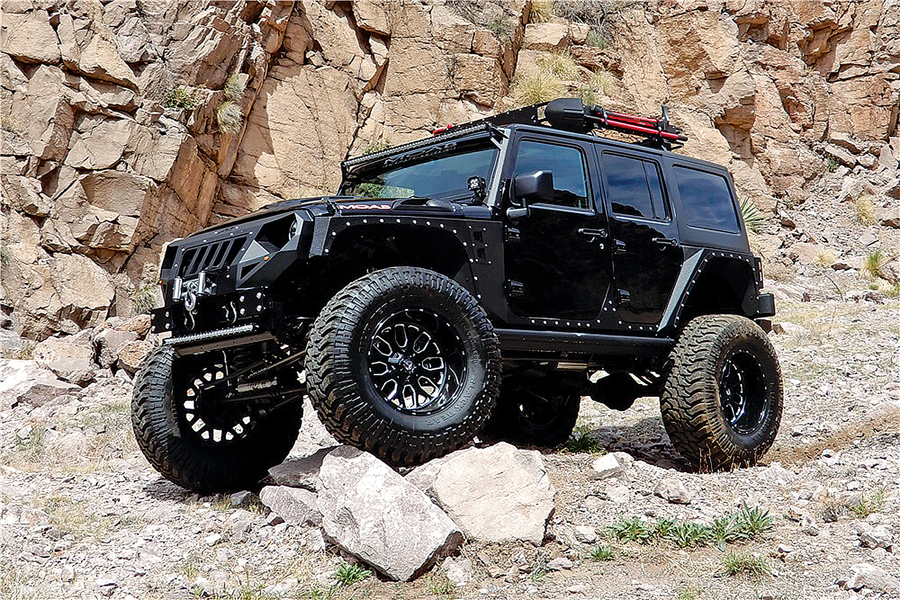
With the red rocky crags and metal-crunching monoliths fresh in my mind, I’d like to take a moment to talk about Moab.
This special place in Utah does everything it can to pulverize you, and the pulverized evidence of the place fills not only your ears and your eyes and your nose, but your soul, too. Moab is one of those few places on Earth that enchants with its harshness and implores with its desolation, which is why so many of us refer to it either in terms of “next time” or “someday.”
Though Moab crawls with vista viewers, craggy climbers, pedal pushers and throttle twisters (that’d be me), it is impossible to speak of the place without also mentioning that other four-letter icon with which the place is synonymous — Jeep.
Whether you’re ambling through downtown, crawling up Poison Spider, whoop-ta-dooing through the Slickrock, or exploring the La Sal Mountains, the Jeeps are there. Some are stock, some are full-on Mall-Terrain Vehicles, some are rentals and some are hand-built masterpieces of tubing and rubber. Either way, their presence is overwhelming.
Where’s the value?
Although I spend most of my time in Moab trying to avoid pitching myself over my handlebars, or worse, into a bottomless abyss, I do my best to keep my eyes up and my ACC goggles on. That being the case, I’d be remiss if I failed to take a look at the current state of the Jeep market.
We’ve been talking about the approaching and now breaching classic SUV tsunami for several years now, and the water is still rising. Somehow, and for reasons that still escape me, the classic Jeeps — CJs, to be specific — aren’t riding the tide.
To be clear, a clean CJ-7 is more expensive now than it was 10 years ago, but the uptick has been granny-gear slow, at least when compared to the growth of virtually any other 4×4 of similar vintage. Why? Is the problem simply a matter of supply and demand, or is there more to it?
No one I knew while growing up owned an FJ or a first-gen Bronco, which we all know have been on an obscene tear in value surge over the past decade. However, more than a few CJ-7s took up space in our high-school parking lot, and they were about as cool a ride as there was. Relatively cheap to own and operate, they were, and are, as great a first car as they are a 10th. They excel at keeping you cold in the winter and hot in the summer. Simple, durable, and almost unparalleled in their attractiveness to the opposite sex, the old Jeeps weasel their way under the skin. Like Moab, they do little to protect you from yourself and sometimes leave you fearing for your life, which some of us would argue is occasionally necessary to remind us we’re alive.
What’s unusual here is that we spend a lot of time talking about the power of nostalgia, but in this case, nostalgia just isn’t cutting it. Based on the experiences of my youth, I’d expect my peers to be pushing the old-Jeep market through the roof, supply be damned. What’s actually happening is my peers are out there throwing logic — and cash — out the window in pursuit of the vehicles we never owned. Why aren’t old Jeeps keeping pace? I have a theory.
A modern take
When I spoke of Moab being inundated with Jeeps, I wasn’t just referring to the CJs. The place is absolutely crawling with JKs — the 4-door Unlimiteds, to be specific. Jeep Wrangler sales have exploded over the past few years, with total new-car sales tripling over the past decade and a half, and they have also managed to work their way into the top 10 of most credible Best Resale Value lists.
If you’ve ever been to SEMA, you’d be hard-pressed to argue against the Jeep Wrangler being easily the most supported vehicle in all of the aftermarket. I saw further evidence of the devotion to accessorization this past January while I sat in the nosebleed section at Barrett-Jackson’s Scottsdale sale. I watched one fat-tired Wrangler Unlimited after another sell for anywhere from $75,000 to $90,000. I couldn’t believe what I was seeing.
Since my trip to Scottsdale, I’ve been keeping my eye on these late-model Jeeps, and lightly used and moderately modified JK Wranglers continue to sell at auction for what I can only describe as absurd amounts of money. The ACC Premium Auction Database has average auction sale prices for 2015-to-2018 Jeep Wranglers ranging from about $60k to almost $80k. Is this trend contributing to the continued disinterest in old CJs? I think so.
The new Wranglers, and the Unlimiteds in particular, may be among the only late-model vehicles on the road that have managed to improve on the original in a way that retains the real essence of their inspiration. New Camaros and Mustangs and Challengers have a splash of retro styling and are faster in every direction than the oldies, but they still look and feel like new cars. And while Jeeps earned their reputation in the rough stuff, the magic has always been about going topless. Now that the Unlimiteds have a whole extra set of doors to leave at home, an actual full-size family of four can pile in — just like with an old Jeep, but better.
As a result, I’ve almost convinced myself that an old CJ-7 might just be one of the best values in classic 4x4s in the current market. Now I just need to convince my wife that we need one. Maybe another trip to Moab will do it.